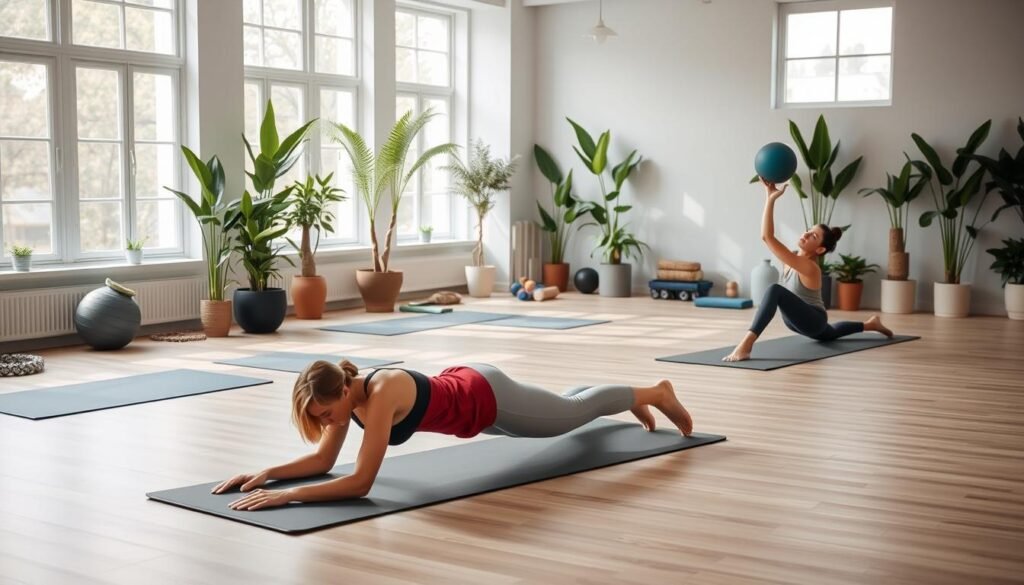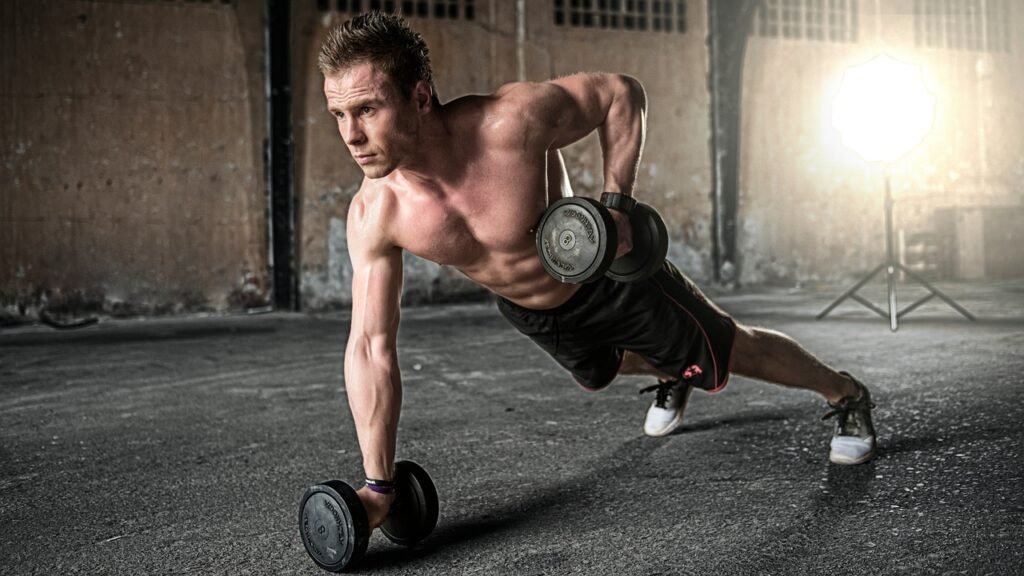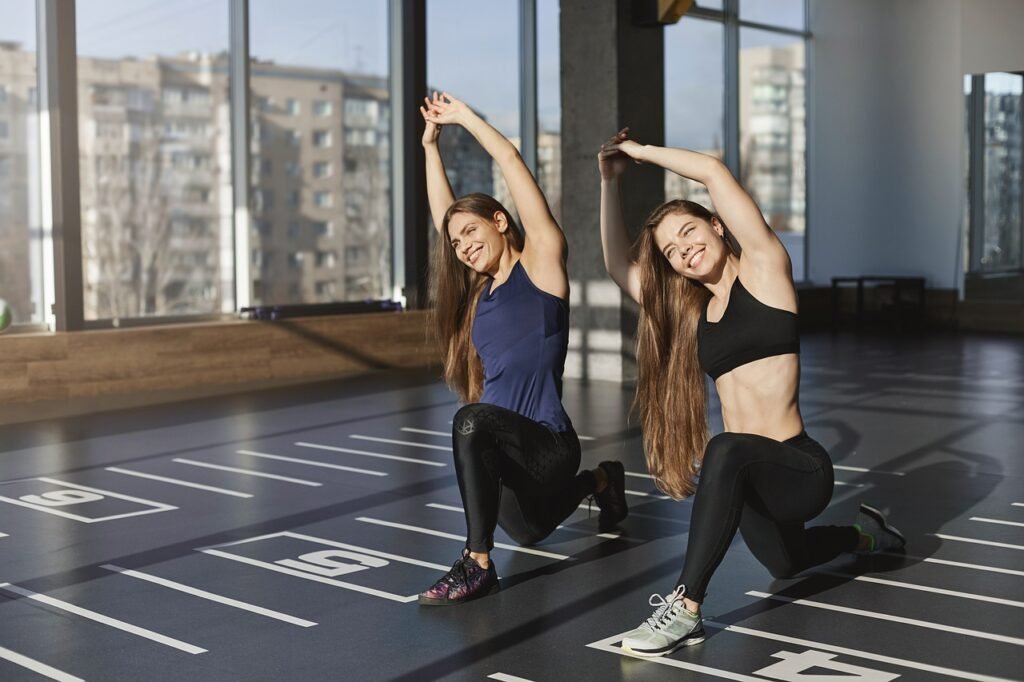Starting your fitness journey? Let’s explore the secret to reaching your full strength – a strong core. Imagine moving easily through your day, from tying your shoes to twisting with grace. Core fitness exercises can make this magic happen.
Your core is the base of your body, giving you stability and strength. It’s vital for anyone, from runners to yogis, or just those wanting to feel more confident. These core exercises will help you become healthier and stronger.
Key Takeaways
- Core fitness training exercises strengthen the abdominal, back, and pelvic muscles for improved stability and balance.
- A strong core makes daily activities and sports performance easier and reduces the risk of injury.
- Incorporating core-strengthening exercises into your fitness routine 2-3 times a week can significantly improve core muscle strength.
- Exercises like planks, dead bugs, and glute bridges are essential for building core strength and stability.
- Variability in core exercises is key to challenging the muscles in different directions and enhance overall core fitness.
Understanding Your Core Muscles and Their Functions
Your core muscles stretch from your neck to your pelvis. They are key in keeping your spine stable, supporting your posture, and allowing smooth trunk rotation. This group of muscles, including the transverse abdominis, internal and external obliques, rectus abdominis, multifidus, and erector spinae, work together. They help keep your body balanced and aligned during daily activities and sports.
Major Core Muscle Groups
The main core muscle groups are responsible for your body’s stability and strength. They include:
- Rectus abdominis – The “six-pack” muscle that runs vertically along the front of your abdomen.
- Obliques – The internal and external oblique muscles that allow for rotation and side-bending of your trunk.
- Transverse abdominis – The deepest abdominal muscle that wraps around your waist, providing stability and support for your spine.
- Erector spinae – A group of muscles that run along your spine, responsible for maintaining proper posture and back extension.
- Multifidus – Small muscles that connect your vertebrae, contributing to spinal stabilization.
Role of Core in Daily Activities
A strong, well-functioning core is essential for everyday tasks and movements. Whether you’re standing, walking, lifting objects, or engaging in sports, your core muscles are constantly activated. They help maintain your balance, posture, and efficient movement patterns. A weak or imbalanced core can lead to issues such as lower back pain, hernias, and an increased risk of upper and lower body injuries.
Benefits of a Strong Core Foundation
Developing a solid core foundation offers numerous benefits for your overall fitness and well-being:
- Improved posture and body alignment
- Enhanced athletic performance and injury prevention
- Increased stability and balance for everyday tasks
- Better support for your spine and pelvic region
- More efficient and coordinated movement patterns
- Reduced risk of low back pain and other musculoskeletal issues
Incorporating core strengthening routines, functional training moves, and core activation techniques into your fitness regimen can help you build a strong, resilient core. This supports your body’s overall health and performance.
Core Fitness Training Exercises for Beginners
Starting your core fitness journey? Begin with these beginner-friendly exercises. They will help build a strong foundation for your abdominal and overall body strength. You’ll work on various core muscle groups, including the obliques, lower back, and glutes.
Begin with 3 sets of 10-12 reps for each exercise. As you get better, increase the difficulty. It’s important to keep a neutral spine during the movements. Make sure to do core training regularly.
- Deadbug: This exercise strengthens the deep core muscles that resist lower back extension, helping to flatten the spine against the floor.
- Plank: A staple in core training, the plank engages multiple core muscles while challenging your stability and endurance.
- Reverse Crunch: Target the rectus abdominis and obliques with this effective abdominal exercise.
- Side Plank: Work your obliques and stabilize your spine with this variation of the classic plank.
- Glute Bridge: This move activates the glutes, core, and hamstrings, providing a well-rounded core workout.
| Exercise | Sets x Reps | Progression Options |
|---|---|---|
| Deadbug | 3 x 10 per side | Add weight, increase reps |
| Plank | 3 x Hold as long as possible | Increase hold time, add arm/leg lifts |
| Reverse Crunch | 3 x 12 | Add weight, increase reps |
| Side Plank | 3 x 30-second hold per side | Increase hold time, add leg raises |
| Glute Bridge | 3 x 15 | Add weight, increase reps |
Core strength and stability are key for fitness, performance, and injury prevention. Be patient and focus on proper form. Gradually increase the intensity of your planking variations, bodyweight training, and abdominal workouts as you build your core fitness.
Advanced Core Strengthening Techniques
Take your core fitness to the next level with these advanced techniques. Move beyond basic crunches and planks. Discover new levels of stability, balance, and strength with plank variations, dynamic movements, and stability ball exercises.
Plank Variations and Progressions
Try advanced plank variations to boost your core endurance and stability. Add side planks with rotation, mountain climbers, and Turkish get-ups to your routine. These exercises work multiple muscles at once and test your balance.
Start with easier versions and gradually increase the difficulty. This will help you progress in your plank training.
Dynamic Movement Patterns
Make your core workouts more exciting with dynamic movements. Try bird dogs with elbow to knee touches. This exercise challenges your stability and works your abdominals, back, and hips.
These functional strength moves improve your performance in daily activities and sports.
Stability Ball Exercises
Add the stability ball to your core workouts for an extra challenge. Crunches, planks, and pikes on the ball require your core to work harder. This helps maintain balance and control.
The unstable surface also engages your stabilizer muscles. This leads to greater core strength and better body control.
“The goal of core strengthening is not just a visible 6-pack but to build a strong core that can efficiently transfer energy to and from the legs and arms.”
Include these advanced techniques in your fitness routine to elevate your workouts. A well-rounded core training program boosts stability, enhances athletic performance, and prevents injuries.
Building Core Stability Through Proper Form
Proper form is key for core strengthening and functional training. The plank is a basic exercise that requires a straight line from head to heels. It also needs engagement of the core muscles and keeping the hips up.
Crunches should lift the shoulder blades without straining the neck. Bridges require squeezing the glutes and keeping the spine straight. Correct form activates the core fully, avoiding reliance on other muscles.
Using the right breathing can also boost core stability. Exhale when you exert and inhale when you recover. This helps engage the core more effectively.
Focus on proper form and breathing to build a strong core. This foundation supports your fitness and athletic performance. It also prevents injuries and improves posture and balance.

“Correct form is the key to unlocking the full benefits of core strengthening exercises. Prioritize quality over quantity, and your core will thank you.”
Building a strong core is not just about doing many exercises. It’s about mastering proper technique and form. This leads to better core stability, strength, and overall health.
Core Activation Techniques and Breathing Patterns
Unlocking your core’s power starts with knowing the right core activation techniques. Your core has many muscles, like the diaphragm and pelvic floor. To use these muscles well, pull your belly button towards your spine while breathing normally.
Proper Core Engagement Methods
To activate your core well, you need a strong connection between your mind and muscles. Imagine your core muscles working as you do exercises. Avoid using other muscles to help, as this can weaken your core. This focused effort will make your functional core training more effective.
Breathing Mechanics During Exercise
Good breathing is key for core activation. Breathe in deeply through your nose and out slowly through your mouth when the exercise is hard. This breathing helps your core muscles work together better and improves your exercise performance.
Mind-Muscle Connection Tips
Building a strong mind-muscle connection is vital for engaging your core. Pay attention to how your muscles feel during pilates-inspired movements and other exercises. This awareness helps you target and strengthen your core better, improving your core activation and strength.
“Addressing the whole core system and breathing patterns together is essential for pelvic health. Practicing Essentrics can benefit pelvic floor health along with overall wellbeing.”
– Kathi Bushway, Level 4 Essentrics Trainer and Certified Occupational Therapy Assistant
Integrating Core Work into Full-Body Training
Getting the most out of your workouts is key, and adding core exercises is a great way to do this. Exercises like squats, deadlifts, and push-ups naturally work your core. To boost core work, try adding instability to your exercises, like doing dumbbell presses on a stability ball.
Another good method is circuit training. This involves switching between core-focused exercises and full-body movements. It makes your workout challenging and keeps your core active and strong.
To effectively add core work to your full-body training, make it a natural part of your routine. By mixing core exercises into your workout, you’ll get the most out of functional strength moves, HIIT core routines, and bodyweight training. This will also help build a solid core foundation.
| Exercise | Description | Benefits |
|---|---|---|
| Squat with Overhead Press | Perform a squat while holding a pair of dumbbells overhead, engaging the core throughout the movement. | Challenges the core, improves overall strength and stability. |
| Plank Row | Assume a plank position, perform a single-arm dumbbell row, then switch arms. | Strengthens the core, back, and shoulders while improving balance and coordination. |
| Stability Ball Pike | Start in a push-up position with your shins on a stability ball, then pike your hips up, engaging the core. | Targets the abdominals, hip flexors, and shoulders for a challenging core workout. |
“Integrating core exercises throughout your full-body workout is the key to developing functional strength and stability.”
Remember, a strong core is the base for a resilient body. By smoothly adding core exercises to your training, you’ll enjoy the perks of functional strength moves, HIIT core routines, and bodyweight training. This will help you perform better and avoid injuries.
Core Training for Sports Performance and Injury Prevention
Functional core training is key for athletes in all sports. It boosts balance, power, and stability. These are vital for top sports performance. Whether you’re into running, golf, or tennis, the right core activation techniques can elevate your game.
Sport-Specific Core Exercises
Runners can benefit from planks and bird dogs to avoid back pain and better their form. Golfers and tennis players should try rotational exercises like stability ball workouts. Adding these exercises to your routine can give you an edge.
Injury Prevention Strategies
Strong core muscles are vital for avoiding injuries, like lower back strains. Studies show that muscle injuries in sports like the NFL and NBA often come from weak cores. Using core activation techniques and proper form can lower injury risks.
Recovery and Maintenance
Keeping your core strong involves regular stretching and foam rolling. This helps prevent injuries and boosts performance. Good recovery and flexibility keep your core muscles ready for your sport.
Adding sport-specific core training to your routine can improve your athletic skills and lower injury risks. A strong, stable core can take your performance to new levels. See the difference on the field, court, or track.
Progressive Core Training Programs
Having a strong core is key for fitness, performance, and avoiding injuries. Start with simple exercises like planks and bridges. Then, move on to functional training moves and Pilates core routines that test your balance and coordination.
Begin with 2-3 core exercises per workout, 2-3 times a week. As you get stronger, add more exercises and make them harder. You can use weights, change how fast you move, or try exercises on unstable surfaces like a BOSU ball.
- Do exercises like Abdominal Bracing, Alternating Leg Marching, and Dead Bug to build stability. Aim for 10 reps per set, 1 set per session, and 2 sessions a day.
- Try Partial Sit-Ups and Single Knee Press to strengthen your core. Do 10 reps per set, with 2 sets in total.
- Improve flexibility with Standing Hamstring Stretch, Standing Hip Flexor Stretch, and Corner Stretch. Hold each for 30 seconds, 3 reps per set, 1 set a day.
A good core strengthening routine should work on stability, strength, and flexibility. Being consistent and gradually increasing the challenge is essential for a strong core that supports your fitness and performance goals.
“A good core workout should be 15 to 30 minutes long and only needs to be done 3 or 4 times a week.”
Core Fitness Training Exercises: Professional Recommendations
Fitness experts say a balanced approach is key for a strong core. This includes stability, rotation, and flexion/extension. Marvin Burton, head of fitness at Anytime Fitness UK, stresses the role of glute strength in supporting the back and core.
Adding yoga core strengthening and pilates-inspired movements to your routine is beneficial. Consistency and proper form are essential for the best results.
Recommended Core Exercises
- Supine Heel Taps (10 reps per leg)
- Marching Glute Bridge (20 reps total, alternating legs)
- Stability Ball Dead Bug (10 reps per side, alternating arm and leg)
- Forearm Plank with Toe Taps (10 reps per leg)
- Side Plank with Torso Rotation (10-12 reps per side)
- Single-Leg Deadlift (12 reps per leg)
These exercises focus on different core functions. They help build a strong, stable, and functional core. Always focus on proper form and engage your core for the best results.
“Improper core training is considered a potent injury mechanism,” according to Dr. Stu McGill, a renowned expert in spinal biomechanics and injury prevention.
By using a balanced core fitness training approach, you can build a strong and stable core. This supports your overall physical performance and well-being.
Conclusion
Core fitness training is key for your overall health and performance. A strong core helps with posture, boosts athletic skills, prevents injuries, and aids in daily tasks. By doing various core exercises, you can build a stable core that offers many benefits.
Studies show that an 8-week core training program helps college athletes a lot. It improves balance, throwing and hitting distances, jump height, and endurance. It also makes running more efficient. These results show how important a good core training plan is for better performance and safety.
To get the most from your core workouts, focus on proper form and practice regularly. Listen to your body too. A mix of core exercises will strengthen, stabilize, and improve your endurance. This will help you in both daily life and sports.






I just could not depart your site before suggesting that I actually enjoyed the standard info a person provide for your visitors? Is going to be back often to check up on new posts
Thank you for the sensible critique. Me and my neighbor were just preparing to do a little research about this. We got a grab a book from our local library but I think I learned more clear from this post. I’m very glad to see such great information being shared freely out there.
Very nice post. I just stumbled upon your blog and wanted to say that I’ve really enjoyed surfing around your blog posts. After all I’ll be subscribing to your feed and I hope you write again soon!